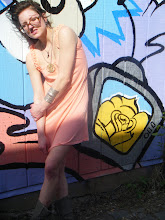Even though the economy has been whispering recession for a while, the effects of the decline probably weren't a major creative influence on fashion designers and their vision of Spring 2009. It's still unknown how current events will influence fashion's direction over the next few seasons, or how consumers will respond to what is offered.
Traditionally, the retail fashion buying cycle begins one year before the actual wearing season, with orders for the clothing placed six months prior. What we see in magazines and on runways today was actually created and developed way before most of us knew we wouldn't have reliable jobs or that stocks would be so low, or even that Obama had a chance of winning the election. Trend forecasting reports have been pushing bright colors as a solution to practical spending....as put by Michael Kors, "When the economy is tough, people want something that looks optimistic. No matter how much doom and gloom goes on, they want to believe that anything is possible."
I don't think it will be that simple to predict this time around. With economists predicting a two year recession, and artists of all mediums and sizes struggling to survive the sudden lack of available credit, it'll be interesting to see both creative and business design choices.
Of course the 1930s come to mind. Depression/Recession comparisons are everywhere, so why not apply it to clothing? Despite the reputation of the decade, Depression Era fashion was far from depressing. The 1930s were actually pretty historic when it comes to style. Hemlines got shorter, new fabrics such as nylon were developed, Schiaparelli invented the zipper, the ready to wear industry was furthered as uniforms were mass produced, and women had their 1st real need for for both daywear and nightwear...
Regardless of a woman's budget, a dress in the 1930s would be worn often and its design had to stand up to being worn well. Clothing couldn't look "out" after several seasons of being worn. Styles became more simple and accessories became important- simply because they had the ability to change the look of the same outfit from one day to the next. Maybe our financial situation and to be determined needs will quality over quantity as a breath of fresh air from the copycat times fashion is currently experiencing.

No comments:
Post a Comment